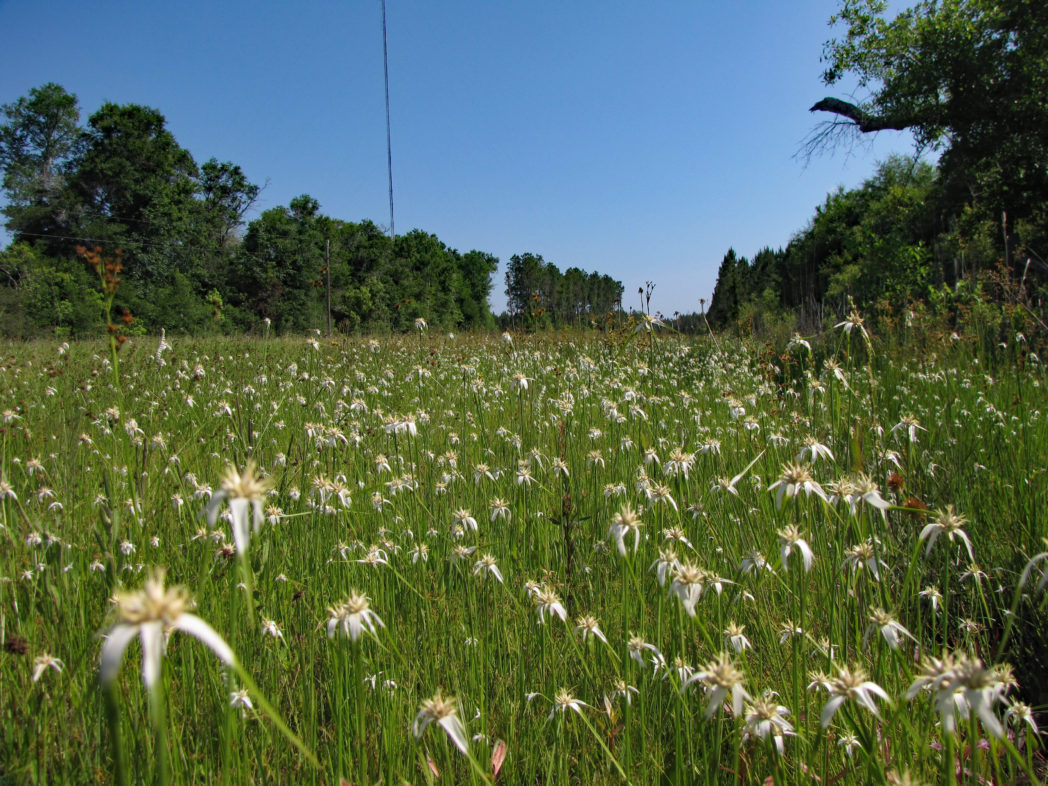Bloom report: Florida’s mild winter has spring wildflowers popping early
Pictured above: Starrush whitetop (Rhynchospora colorata) along County Road 357 in Dixie County. Photo by Jeff Norcini
Spring is the time of year that many of us associate with blooming plants – for good reason. Not only are countless wildflowers in bloom, but many trees, shrubs and vines are blossoming as well.
Expect to see at least some native wildflowers bloom earlier than normal this spring because of the mild winter, especially in North and Central Florida. Native wildflowers that began blooming earlier than normal include Blanketflower (Gaillardia pulchella), Blue-eyed grass (Sisyrinchium angustifolium), Lady lupine (Lupinus villosus) and Lanceleaf tickseed (Coreopsis lanceolata) in North Florida, and Skyblue lupine (Lupinus diffusus) in Central Florida.
Interestingly, Nancy Bissett of The Natives in Davenport notes that peak bloom of Carolina jessamine (Gelsemium sempervirens) was in late February, about a month later than normal in Central Florida, seemingly because of the mild winter. It peaked in late February in north Florida as well, and is nearly done flowering across the state.
Expect fewer native wildflowers to bloom earlier than normal in South Florida because of less disparity in winter temperatures. However, botanist Roger Hammer of Homestead mentioned he saw Simpson’s grasspink (Calopogon tuberosus var. simpsonii) and Florida dancinglady orchid (Oncidium floridanum) flowering sooner than expected.
Spring blooms to continue through May
Given the fair chance of above-normal temperatures and rain throughout the state, especially peninsular Florida, expect a good show of native wildflowers through May, with some of the typical summer flowering species popping early, too.
The best place to see Florida native wildflowers is in natural areas, such as along trails in nature preserves and pine forests that are subject to prescribed burns. Roadsides in these areas are good as well. Many of the showiest native wildflowers in natural areas, such as those listed below, occur in moist to slightly moist areas throughout the state. Flowering times vary with region. Wildflowers blooming now in South Florida might not bloom until mid- to late spring in the Panhandle.
Click on the names below for range maps and photos.
- Canadian toadflax (Linaria canadensis)
- Common blue violet (Viola sororia)
- Leavenworth’s tickseed (Coreopsis leavenworthii)
- Lyreleaf sage (Salvia lyrata)
- Nuttall’s thistle (Cirsium nuttallii)
- Pineland daisy (Chaptalia tomentosa)
- Purplehead sneezeweed (Helenium flexuosum)
- Roundleaf bluet (Houstonia procumbens)
- Rosy camphorweed (Pluchea baccharis)
- Savanna iris (Iris savannarum)
- Southeastern sneezeweed (Helenium pinnatifidum)
- Spring ladiestresses (Spiranthes vernalis)
- Starrush whitetop; Whitetop sedge (Rhynchospora colorata) (pictured above)
- String-lily (Crinum americanum)
- Yellow butterwort (Pinguicula lutea)
- Yellow colicroot (Aletris lutea)
Don’t pick the flowers!
When you are in a natural area enjoying the spring beauty that Mother Nature has blessed us with, please don’t pick wildflowers. If you want to preserve a wildflower memory, take a picture — it will last longer.
And speaking of pictures, you can submit photos of your native wildflower sightings to the Florida Wildflower Foundation for inclusion on its What’s in Bloom map or post them to its Florida Native Wildflowers Facebook group and Florida Wildflowers Flickr group. Please include the plant’s scientific name (common name is OK) and the location. If you are uncertain about a wildflower’s nativity to Florida, consult the Atlas of Florida Plants before posting. If submitting a photo to the Foundation’s Facebook group and you can’t identify it using the Atlas, inquire about nativity when posting. There are many other good botany resources noted in the group’s rules.
About non-native spring blooms
While there are many wildflowers that bloom in the spring, wildflowers in disturbed areas like roadsides, residential and commercial landscapes and pastures can be a mix of native and non-native species. The following spring wildflowers are showy and have some value to pollinators but are not native to Florida.
- Drummond Phlox (Phlox drummondii)
- Many clovers and clover-like plants, including
Dr. Jeff Norcini serves as a Florida Wildflower Foundation consultant through his business, OecoHort, LLC, and is FDOT’s Wildflower Specialist. Thank you to Nancy Bissett and Roger Hammer for their observations.

